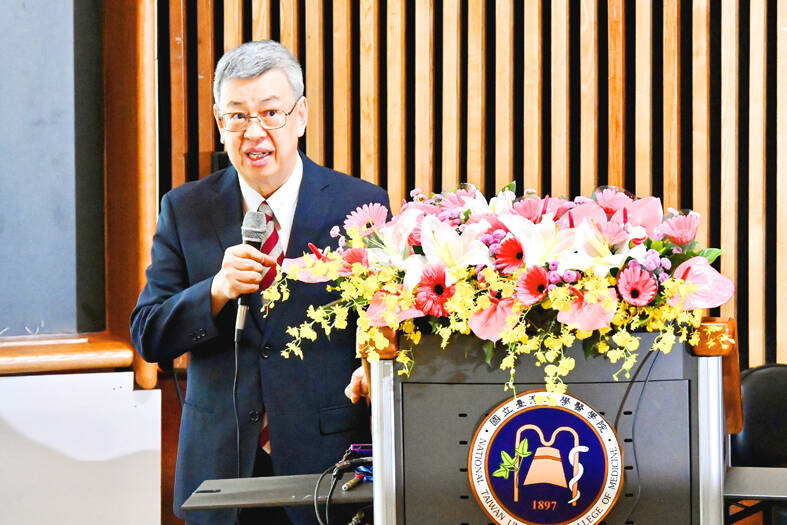The nation’s first brain bank opened in Taipei yesterday, with Premier Chen Chien-jen (陳建仁) expressing his hopes that it would also make Taiwan a bellwether in neuroscience in Asia.
National Taiwan University’s (NTU) College of Medicine yesterday hosted a plaque unveiling ceremony for the Taiwan Brain Bank, which was attended by Chen, National Health Research Institutes president Sytwu Huey-kang (司徒惠康), NTU vice president Chang Shan-chwen (張上淳), Minister of Health and Welfare Hsueh Jui-yuan (薛瑞元) and Taiwan Brain Bank Association chairman Hsieh Sung-tsang (謝松蒼).
“Many chronic diseases affecting the nation’s increasingly aging population — such as dementia and Parkinson’s disease — are related to the brain,” Chen said.

Photo: Lin Hui-chin, Taipei Times
“The establishment of the Taiwan Brain Bank would help scientists study various cerebral diseases, which could help prevent people from getting them and enable medical experts to begin patients’ treatment early,” he said. “This would also make Taiwan a bellwether in brain science in Asia.”
The brain bank belongs to the nation, not NTU, Chang said.
“Today is only the beginning, and the brain bank cannot sustain itself with the budget allocated to the medical school alone. We are calling for long-term financial support from the government,” Chang said.

Photo: George Tsorng, Taipei Times
In the past, the focus of neuroscience was studying data gathered through neuroimaging, Hsueh said, adding that the brain bank would allow neuroscientists to analyze brains directly.
“We understand that funding is needed to maintain the operations of the brain bank, so part of the technology budget would be used for this purpose. Another challenge would be to encourage voluntary donations of brains, which requires joint cooperation of the medical community and different patient groups,” Hsueh said.
“People need to know the importance of organ donations and give their consent to donate while they are alive. Their families should also give their consent,” he said.
There are about 150 brain banks worldwide, Hsieh said, adding that having brain banks is an indicator of prosperity.
“Unlike brain banks in other countries that were established by the government, the Taiwan Brain Bank was initiated by patients and their relatives who wanted to contribute by donating their brains for research,” Hsieh said.
Hsieh began leading a workforce to establish the brain bank in 2017, when they faced the challenge of finding a legal basis for such an institution. The problem was resolved after the Ministry of Health and Welfare issued interpretations of relevant regulations.
The brain bank also spent three years training its personnel and installing relevant facilities before it was officially established yesterday.

Taiwan is gearing up to celebrate the New Year at events across the country, headlined by the annual countdown and Taipei 101 fireworks display at midnight. Many of the events are to be livesteamed online. See below for lineups and links: Taipei Taipei’s New Year’s Party 2026 is to begin at 7pm and run until 1am, with the theme “Sailing to the Future.” South Korean girl group KARA is headlining the concert at Taipei City Hall Plaza, with additional performances by Amber An (安心亞), Nick Chou (周湯豪), hip-hop trio Nine One One (玖壹壹), Bii (畢書盡), girl group Genblue (幻藍小熊) and more. The festivities are to

Auckland rang in 2026 with a downtown fireworks display launched from New Zealand’s tallest structure, Sky Tower, making it the first major city to greet the new year at a celebration dampened by rain, while crowds in Taipei braved the elements to watch Taipei 101’s display. South Pacific countries are the first to bid farewell to 2025. Clocks struck midnight in Auckland, with a population of 1.7 million, 18 hours before the famous ball was to drop in New York’s Times Square. The five-minute display involved 3,500 fireworks launched from the 240m Sky Tower. Smaller community events were canceled across New Zealand’s

‘IRRESPONSIBLE’: Beijing’s constant disruption of the ‘status quo’ in the Taiwan Strait has damaged peace, stability and security in the Indo-Pacific region, MOFA said The Presidential Office yesterday condemned China’s launch of another military drill around Taiwan, saying such actions are a “unilateral provocation” that destabilizes regional peace and stability. China should immediately stop the irresponsible and provocative actions, Presidential Office spokeswoman Karen Kuo (郭雅慧) said, after the Chinese People’s Liberation Army (PLA) yesterday announced the start of a new round of joint exercises around Taiwan by the army, navy and air force, which it said were approaching “from different directions.” Code-named “Justice Mission 2025,” the exercises would be conducted in the Taiwan Strait and in areas north, southwest, southeast and east of Taiwan

UNDER WAY: The contract for advanced sensor systems would be fulfilled in Florida, and is expected to be completed by June 2031, the Pentagon said Lockheed Martin has been given a contract involving foreign military sales to Taiwan to meet what Washington calls “an urgent operational need” of Taiwan’s air force, the Pentagon said on Wednesday. The contract has a ceiling value of US$328.5 million, with US$157.3 million in foreign military sales funds obligated at the time of award, the Pentagon said in a statement. “This contract provides for the procurement and delivery of 55 Infrared Search and Track Legion Enhanced Sensor Pods, processors, pod containers and processor containers required to meet the urgent operational need of the Taiwan air force,” it said. The contract’s work would be